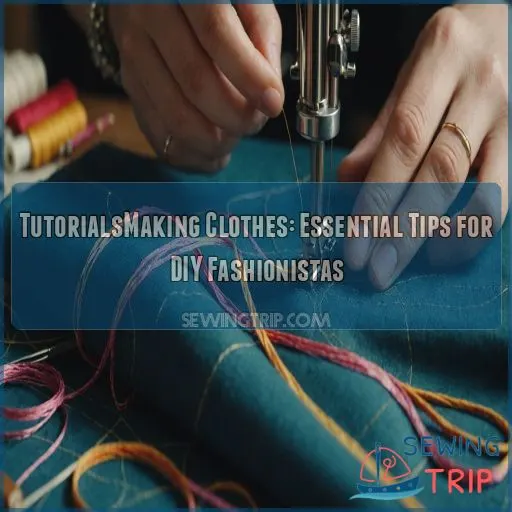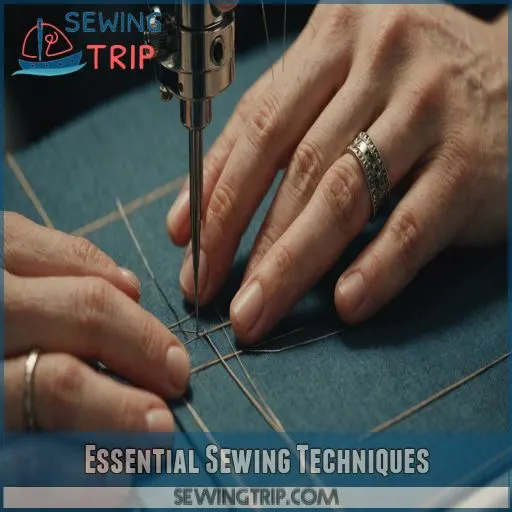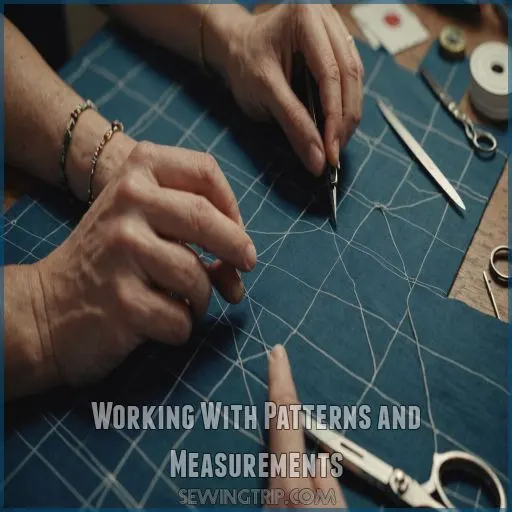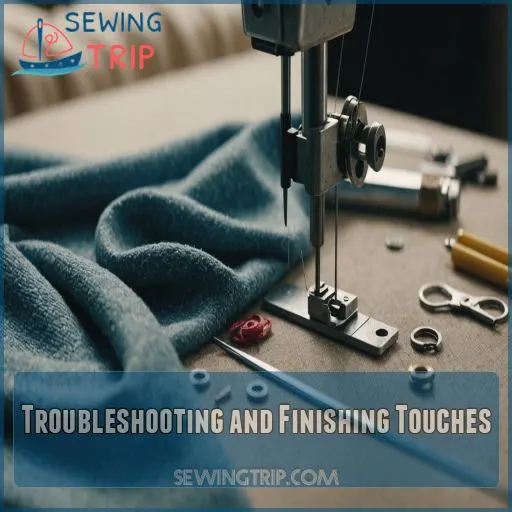This site is supported by our readers. We may earn a commission, at no cost to you, if you purchase through links.

When you’re exploring tutorials on making clothes, start by choosing fabrics that dance with your style and climate.
Mastering essential sewing techniques is like learning the guitar chords – practice makes perfect.
Whether it’s zippers that don’t zip or seams that seem off, there’s a solution for every sewing conundrum.
Digging into patterns and measurements makes sure a fit that’s Goldilocks-approved – just right.
Curious how to sprinkle magic onto every stitch? Stick around for sewing secrets that transform fabric bolts into wardrobe gold.
Table Of Contents
Key Takeaways
- Choosing the right fabric is like picking the perfect ice cream – it needs to match your style, mood, and the weather. Don’t shy away from fabric markets for hidden gems that can transform your sewing project from mundane to marvelous.
- Mastering basic sewing techniques is your ticket to fashion freedom, especially when working with Scuba fabric. It’s like learning guitar chords; practice makes perfect. Start with the fundamental stitches, and you’ll soon be handling zippers, buttons, and even those tricky hems like a pro.
- Designing your own garments? Think of your body as the canvas, and mastering measurements as your brush. Whether you’re tracing a favorite shirt or drafting your own pattern, the right fit makes you feel like you’re wearing a second skin – minus the tight squeeze.
- Adding finishing touches is the cherry on top of your sewing masterpiece. Spice up your creations with embellishments like embroidery or lace trims. Remember, each piece you sew tells a story, so make sure it sings loud and clear.
Choosing the Right Fabric
Choosing the right fabric is like picking the perfect ice cream flavor—it depends on your mood, the occasion, and sometimes the weather!
Whether you’re crafting a cozy winter coat or a breezy summer dress, mastering fabric selection can transform your creation from "meh" to marvelous.
Understanding Fabric Types
Get to know the world of fabric by exploring its rich tapestry!
Understanding fabric types is like opening a treasure chest: each textile has unique origins, properties, and charm.
From fabric weight to choosing the right yarn, knowing your material is half the battle.
Treat it well; remember, proper fabric care makes your creations last, keeping them runway-ready for years!
Selecting Fabric for Specific Garments
When selecting fabric for a specific garment, consider these key factors:
- Fabric weight: Choose a weight that suits the garment’s purpose – lightweight for breezy tops, heavier for structured pieces.
- Fabric drape: Opt for fabrics with the right amount of flow or structure to flatter your figure.
- Fabric texture: Smooth, crisp cottons for sharp looks; soft, drapey fabrics for comfortable, casual styles.
- Fabric stretch: Incorporate stretch for ease of movement and a comfortable fit.
Considering Seasonal and Personal Preferences
Choosing fabrics is like dressing your mood for the weather.
In blazing summer, opt for breathable linen, while winter calls for cozy wool.
Let your personal taste shine through color palettes that suit your style trends.
Sourcing Affordable and High-Quality Fabrics
Anyone who’s gone fabric shopping knows it can be a wild adventure.
First, scout local fabric markets for hidden gems.
Second, check online fabric stores for deals—don’t forget reviews for quality checks.
Tips for Working With Different Fabric Textures
You’ve found the perfect fabric, but its drape and texture impact your sewing techniques! Think of it like a tango—flowy fabrics sway, while stiff ones demand control.
Adjust patterns accordingly to dance with the material’s natural grace.
Don’t forget finishing touches to avoid fraying.
With practice, you’ll waltz through any textile challenge and create beautifully crafted garments.
Essential Sewing Techniques
Sewing may seem intimidating, but with the right techniques, you’ll be stitching up a storm in no time!
From mastering basic stitches to working with zippers and buttons, this section will equip you with the essential skills to bring your DIY fashion dreams to life.
Mastering Basic Stitches and Knots
Now that you’ve nailed fabric type, let’s tackle basic stitches and knots.
Stitch types are your secret weapon.
You’ll need these hand sewing tools: 1. Needles of various sizes. 2. Thread matching your fabric. 3. Scissors, sharp as a tack. 4. A trusty thimble.
Need sewing machine basics too? It’ll sew like a dream!
Understanding Seam Allowances and Grain Lines
Ever sewn a shirt only to find one sleeve feels wonky? That’s your seam allowance and grain line misbehaving! Seam allowance variations help your seams sit pretty, while grain line impact is like a compass guiding your fabric’s fibers.
Watch that fabric bias—curved seams are trickier!
Pattern adjustments, trusty sewing tools, make your fashion dreams a reality.
Working With Zippers, Buttons, and Other Fasteners
Understanding seam allowances gives you a solid foundation; like life’s little zippers, buttons, and snaps, you can easily conquer any fastener obstacles.
Start with zipper installation techniques—steady hands, steady heart.
For buttons, straightforward: buttonhole sewing tips save you from sewing blues.
Fastener troubleshooting? No sweat.
Some sewing with snaps adds a dash of flair.
Choose the right fastener, and fashion magic happens!
Creating Hems, Seams, and Edges
With a few simple hemming techniques, you can elevate the look of your handmade garments.
Start by pressing your fabric edges with a hot iron – this will create crisp, professional-looking hems.
Next, experiment with different seam finishes like zigzag or overlock stitches to prevent fraying.
Finally, explore edge treatments like bias binding or topstitching to add a polished touch.
Tips for Sewing in a Straight Line
To sew in a straight line, think of your sewing machine like a trusty steed guiding you along fabric highways.
Utilize straight-stitch techniques by aligning fabric edges with machine guides.
Frequent ironing helps make for smoother roads.
Hand-sewing tricks, like chalk marking, are saviors for curves.
Practice these sewing machine basics, and your stitches will sing straight like an arrow.
Designing Your Own Garments
Designing your own garments can be an exciting journey, allowing you to express your unique style while considering body measurements and personal preferences.
You’ll create patterns or tweak existing ones, adding embellishments to craft a personalized wardrobe that’s both fashionable and functional.
Understanding Body Measurements and Fit
Grasping your body proportions is the golden ticket to nailing fit. Picture yourself as an artist, measuring the canvas:
- Bust fitting is key—ensure no gaping.
- Waist shaping enhances comfort.
- Sleeve length should let you wave gracefully.
- Pants fit, ah, no parachute pants!
Chuckles aside, focus on tailoring to accentuate.
Creating a Pattern or Using Existing Ones
Creating your own pattern is like getting a secret sewing superpower!
Start by tracing an existing garment you love – it’s a foolproof way to get the fit just right.
Or get into pattern drafting for a truly custom look.
Either way, the possibilities are endless when you’re the designer.
| Pattern Tracing | Pattern Drafting |
|---|---|
| Use an existing garment as a template | Draft a pattern from scratch using your measurements |
| Quick and easy for beginners | Allows for complete customization |
Designing for Different Body Types and Styles
Designing clothes that suit your body shape and personal style can feel like a puzzle.
Solve it with humor and flair by considering:
- Flattering silhouettes that highlight your best features.
- Style trends adapted to your unique personality.
- Wardrobe basics that fit like a glove.
Adding Embellishments and Details
Boost your creativity by adding embellishments like embroidered designs, sewing beads, or lace trims.
Imagine your garment as a canvas, ready for ribbon details and patchwork elements.
It’s like playing dress-up, but with more control and satisfaction.
Don’t sew your wild oats, sew your style dreams.
Creating a Personalized Wardrobe
You’ve added all the embellishments; now it’s time to craft your unique, sustainable sewing story. Embrace thrift flip style and upcycled fashion to make a DIY wardrobe that showcases your flair:
- Tailor pieces for a custom fit.
- Mix timeless classics with quirky finds.
- Inject personal flair with color and texture.
- Enjoy the process—it’s fashion meets freedom!
Working With Patterns and Measurements
Mastering the art of pattern work and body measurements is key to achieving a flawless fit.
From decoding pattern symbols to crafting a custom pattern from scratch, this section will guide you through the essential techniques to elevate your DIY fashion game.
Understanding Pattern Symbols and Markings
After channeling your inner designer, you’re now exploring the language of pattern symbols and markings, your secret code for sewing mastery.
Visualize these symbols as a pattern glossary—decoding them opens up your creativity.
Use guides for common markings like notches and grainlines, crack the pattern language, and read layouts like a pro.
Master this, and you’ll sew with confidence.
Taking Accurate Body Measurements
Spotting those pattern symbols was a breeze, right?
Now, measuring tools are your new best friends.
Accurately measuring your body helps prevent fitting issues.
Follow a reliable measurement guide and you’ll sew clothes that fit like a glove—unlike that holiday sweater from Aunt Marge.
Tailor-made perfection awaits!
Modifying Patterns for a Perfect Fit
Nailing down the perfect fit can feel like trying to catch lightning in a bottle, but don’t fret.
To modify patterns effectively, try these steps:
- Bust adjustments make sure you get a flattering fit.
- Sleeve alterations improve comfort.
- Waist shaping adds flair.
- Length modifications perfect the look.
Each tweak turns the ordinary into fashion magic!
Creating a Custom Pattern From Scratch
Creating your own custom pattern from scratch is an empowering way to achieve the perfect fit, like you can create your own cross stitch patterns with a helpful guide.
Grab your measuring tape and let’s get started!
First, map out your body measurements – this is the foundation for drafting a pattern that hugs your curves just right.
With a little creativity and a few simple tools, you can design garments that flatter your unique shape.
Tips for Working With Commercial Patterns
Now, let’s tackle commercial patterns. Selecting the right size feels like mission impossible sometimes, but you’ve got this! Use a tape measure, not your ego, for accurate measurements.
Marking techniques are your roadmap—never skip those!
Fabric choice matters too; match it to the pattern’s fabric suggestions. For inventive freedom, embrace pattern alterations for a personalized twist.
Troubleshooting and Finishing Touches
You’ve made it this far with your garment, but don’t let minor mishaps unravel your sewing dreams.
Let’s tackle common sewing mistakes, add those professional finishing touches, and make sure your creation doesn’t end up in the "what-was-I-thinking" pile.
Common Mistakes and How to Fix Them
Sometimes, between the fabric choice and the final stitch, you can hit a snag—or, heaven forbid, a seam ripper! It’s all part of the journey.
Check your pattern fitting and make sure your project planning is sound.
Sewing errors happen, but don’t panic! Think strategically, like a tailor in a storm, and you’ll sew through with ease.
Adding Finishing Touches to Your Garments
Once the main construction is complete, it’s time to add those special finishing touches that elevate your garment.
Start by mastering buttonholes – they can make or break an outfit.
Next, explore seam finishes like French seams or bias binding to create a polished look.
And don’t forget hemming – try different techniques like blind stitches or rolled hems for a professional finish, like using a serger for a neat, stretchy stitch like using a serger.
Working With Interfacing and Stabilizers
Occasionally, choosing the right interfacing or stabilizer feels like picking the perfect ice cream flavor. With many types of interfacing, understanding their uses is key.
Think of interfacing as the hidden strength, offering structure, while stabilizers prevent stretching.
Mastering application techniques makes sure garments look polished and feel professional.
Creating a Professional-Looking Finish
Achieving a professional-looking finish is like adding the cherry on top of your sewing project.
Pay attention to pressing seams impeccably; it creates clean edges and that polished flair.
Consider topstitching for extra style points.
Use seam finishes like zigzag or serged edges to prevent fraying.
These finishing touches are your secret weapons for fabric finesse!
Tips for Caring for and Altering Your Garments
With your garment’s professional finish in place, keeping it in tip-top shape is next.
Use proper sewing tools for mending techniques, ensuring your creations last like the ones mentioned in this helpful guide.
Store garments carefully—no one wants them wrinkled like grandma’s old couch.
For stubborn stains, trust reliable fabric repair and stain removal methods like removing pencil marks from embroidery.
This way, your wardrobe stays fresh and ready for any fashion adventure!
Frequently Asked Questions (FAQs)
What materials are best for sewing machines?
Sewing machines thrive on natural fibers – cotton, linen, and wool.
These materials glide effortlessly through the needle, creating a smooth, professional finish.
Synthetic fabrics can gum up the works, so steer clear for a seamless sewing experience.
How do I organize sewing supplies efficiently?
Organize sewing supplies like a maestro conducting a symphony.
Use labeled containers, pegboards, and magnetic strips for tools.
Create a sewing haven where fabric, threads, and buttons gracefully dance at your fingertips, sparking creativity and efficiency!
What are the environmental impacts of fabric choices?
Choosing your fabric isn’t just about looks; it’s the planet’s makeover too!
Synthetic fabrics release microplastics, while cotton drinks water like a fish.
Opt for eco-friendly options like hemp and save resources, sparing environmental headaches (Source).
How to incorporate sustainability in sewing projects?
You can make sewing projects eco-friendly by using organic fabrics, upcycling old garments, and choosing sustainable materials, just like ThreadCrate’s commitment to sustainability.
Add small changes like zero-waste patterns—easy peasy!
Explore thrift stores for fabric gems, giving new life to old treasures.
What online resources offer sewing community support?
Join the vibrant world of online sewing communities, where you’ll find a wealth of support, inspiration, and skill-building resources to elevate your stitching journey. (Source)
Expert-led courses, interactive live streams, and a supportive network of fellow sewists are just a few of the resources available to you. (Source)
Conclusion
Like weaving a tapestry, crafting your own clothing through tutorials on making clothes allows you to blend threads of creativity and skill into something truly unique.
You’ve uncovered the secrets to transforming fabric into fashion, mastering each stitch with the grace of a seasoned tailor.
Now’s your chance to stitch your personal essence into every garment.
So, grab those scissors and needles, ready to make every piece from your wardrobe a masterpiece that tells your story.











